Top News
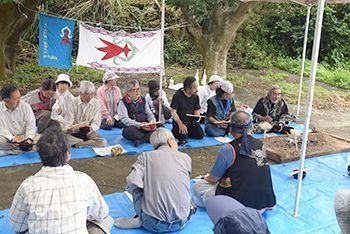
May 24, 2019 Ryukyu Shimpo
(Itoman) On May 17, the Uruma Association in Solidarity with the Ainu People (representative: Shinya Mayonaka) held an Ainu memorial service (“Icharupa”) in front of the Nanboku Tower in Maehira, Itoman to honor the souls of Ainu soldiers and Okinawans who perished in the Battle of Okinawa. Around 30 people from Hokkaido, Kanto, Kansai, and other places outside Okinawa, as well as Uruma Association members, Maehira residents, and others participated in the service and offered a prayer, wishing for peace and friendship between the Ainu and Okinawa.
The Uruma Association in Solidarity with the Ainu People, in cooperation with the “Anti-‘Northern Territories Day’! Carry out the ‘New Ainu Law’! National Executive Committee,” holds a memorial service every year around May 15, the day of the Okinawan reversion to Japan. This year’s was the twentieth service.
“We had our language and culture stolen from us, and were treated almost identically to the Ryukyuans. I hope to forever continue offering condolences at the Nanboku Tower,” said Shinritsu Eoripakku Ainu Kawamura, 68, director of the Kawamura Kaneto Ainu Memorial Hall in Asahikawa, Hokkaido and chair of the Asahikawa Ainu Association.
Kawamura and others surrounded a flame dressed in traditional Ainu clothing and gave an offering of rice wine to the god of fire and the god of the Okinawan land, praying in the Ainu language. The women took fruit and snacks and ate half, offering the other half to the ancestors, and offered a quiet prayer.
(English translation by T&CT and Sandi Aritza)
Go to Japanese

May 26, 2019 Ryukyu Shimpo
After war separated her from her father her entire life, Zenaida Sumiko Fusato, 78, who was orphaned in the Philippines during the war, landed at Naha Airport May 25, and set foot in her father’s hometown in Okinawa for the first time. Sumiko, who was greeted and embraced by her half-brother Toshio Fusato (71, from Uruma) reflected happily, “I thought my father had forgotten about us, but what has happened here today is thanks to him.”
Sumiko’s father, Okinawan-born Seihan Fusato, died in 1996, and her mother, second-generation Japanese-Filipino Antonia Terada, died during the war in 1945.
After the war, the orphaned Sumiko, paid her way through school by helping out with housework at a relative’s house. It was then that an aunt on her mother’s side found Sumiko’s father’s birth certificate, and she learned that her father was “Yamato Fusato.” It seem that Yamato was a childhood name.
While looking for her father, she learned in 2007 in a survey conducted by the Philippine Nikkei-jin Legal Support Center, she learned that her father was Kiyoshige Fusato. She also learned that Kiyoshige was forced to return to Okinawa after the war, and that he had already died. Toshio learned that he had an older sister from a friend of his father. Kiyoshige never spoke of his past life in the Philippines, but on his death bed asked a favor of the friend.
The first time Sumiko and Toshio met was in 2015, 70 years after the end of the war. Sumiko had tears of joy as her long-held prayers to meet her father’s family had finally come true. Tohsio, who was deeply moved by this though, “I want to take her to visit father’s grave,” and brought Sumiko to Okinawa for the first time.
On May 26, Sumiko visited Tsuken, where Kiyoshige is laid to rest. “I visited my father’s grave. I could not wish for anything more.” She beamed with joy over being reunited with her father.
(English translation by T&CT and Sam Grieb)
Go to Japanese
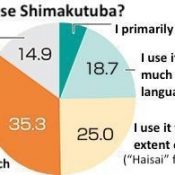
May 24, 2019 Ryukyu Shimpo
On May 23 the Okinawa Prefectural Government (OPG) announced the results of the 2018 Shimakutuba (Okinawan language) prefectural survey. In regard to Shimakutuba, those who answered that they “primarily use it,” “use it about as much as standard language” and “use it to the extent of greetings,” accounted for 49.8 percent of respondents, a decrease of 4.8 percentage points from the previous year’s survey.
Separated by age, respondents who said they “primarily use” Shimakutuba and “use it about as much as standard language” accounted for the following percent of their respective age groups in the 2018 survey; teens at 10.7 percent, 20’s at 13.5 percent, 30’s at 15.5 percent, 40’s at 17.1 percent, 50’s at 18.9 percent, 60’s at 44 percent, and 70’s or older at 59 percent.
As for the necessity of using Shimakutuba, 78.6 percent of respondents said they think it is “very necessary” or “somewhat necessary,” which is a 1.9 percentage point increase from the previous year. Those who answered that they use Shimakutuba in business and in public places accounted for 43.9 percent of respondents.
Although people feel it is necessary to use Shimakutuba, the percentage of those who answered they do not use it in their daily lives has increased.
This poll was first taken in 2013 and this is the fourth such poll. The 2018 survey was conducted between December last year and March this year, with responses numbering 2,552 in total.
The OPG has set a goal for 88 percent of prefectural people to be able to speak Shimakutuba to the extent of greetings by 2022. Kenichi Arakaki, the director-general of the OPG’s Department of Culture, Tourism and Sports, said, “I want to steadily continue activities such as training Shimakutuba instructors.”
(English translation by T&CT and Erin Jones)
Go to Japanese

May 20, 2019 Ryukyu Shimpo
By Yoshiki Nagahama
Four people originally from Okinawa gathered in Portland parish in Jamaica and successfully carried out an educational class for disaster prevention via dance. Reggae dancer Ivan, originally from Ginowan, livened up more than 150 students and faculty at the parish’s Boundbrook Primary School through his choreographed “Disaster Prevention Dance.” Through dance, he deepened people’s knowledge about disasters.
The activity was put together by 31-year-old Hideichiro Nakamura originally from Nakagusuku Village. Nakamura has been taking part in disaster prevention education in Jamaica since last January as Japan International Cooperation Agency’s (JICA) Japan Overseas Cooperation Volunteer (JOCV). In addition, 28-year-old Haruna Higa of the Embassy of Japan in Jamaica from Naha handled the advertising, while photographer Ryuichi Ishikawa from Ginowan recorded the event.
According to Nakamura, since Jamaica does not experience many earthquakes and tsunamis, some children were not even aware of their existence. They enjoyed learning the rippling moves of a tsunami and the ground shaking moves of an earthquake via dancing to the reggae music the DJ played.
The principal of the school happily said, “The choreography was easy to learn, which made it creative and fun to learn. I’d want them to do this again.” He was also surprised at “how well the Japanese dance reggae (since reggae dance originates from Jamaica).”
Higa reflected on the experience and said, “I think that there are a lot of things that Japan, which has many experiences with disasters, can convey to Jamaica, a fellow island nation. I was honored to have been able to work with three other people with different professions from Okinawa in Jamaica.”
Nakamura said, “I hope that through fun classes, people can proactively heighten their awareness regarding disaster prevention.” He thereby advocated “disaster prevention education that is sustainable” and hopes that this will lead to future opportunities.
(English translation by T&CT and Chelsea Ashimine)
Go to Japanese
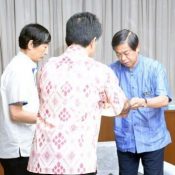
May 23, 2019 Ryukyu Shimpo online edition
On the morning of May 23 Okinawa Vice Governor Kiichiro Jahana called Ambassador in charge of Okinawan Affairs Hiroshi Kawamura and Director General of the Okinawa Defense Bureau Toshinori Tanaka to the Prefectural Office. Vice Governor Jahana submitted a letter of protest to the other two concerning the May 21 parachute drop training exercise that was conducted by the U.S. Air Force at Kadena Air Base.
The U.S.-Japan Special Action Committee on Okinawa (SACO) 1996 Final Report sets forth that parachute drop training be conducted at Ie Jima Auxiliary Airfield. After receiving notice that the training was to be conducted in Kadena, Mayor of Kadena Town Hiroshi Toyama appealed on May 20 to the Okinawa Defense Bureau (ODB), the U.S. Air Force 18th Wing, and the Ministry of Foreign Affairs Okinawa Liaison Office, asking that parachute drop training not be conducted in Kadena. Chatan Town and the Okinawa Prefectural Government proposed this stoppage to the ODB the same day.
Ambassador Kawamura disclosed that the U.S. officials had explained that the initial plan was to conduct the training at Iejima, but due to bad weather conditions such as high waves it was difficult to conduct the training there. Director General Tanaka explained, “At the time the waves measured 2 or 3 meters, so they could not have used lifeboats.”
Vice Governor Jahana refuted, “We are entrusting the U.S. with judgment calls. The weather allowed for diving at the time of training. I hope you take action such as discussing this in the U.S.-Japan Joint Committee once again.” He made plans to appeal to the U.S. military and U.S. consulate general on May 24.
(English translation by T&CT and Erin Jones)
Go to Japanese
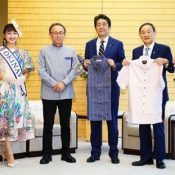
May 21, 2019 Ryukyu Shimpo
[Tokyo] With summer just about to kick off, Okinawa governor Denny Tamaki presented Okinawan Kariyushi attire to Prime Minister Shinzo Abe, Chief Cabinet Secretary Yoshihide Suga, and Minister of State for Okinawa and Northern Territories Affairs Mitsuhiro Miyakoshi. The cabinet ministers plan to wear the clothing while conducting a cabinet meeting June 6, and Prime Minister Abe commented, “In the six years the Abe administration has been in office, we have been interested in the 400,000 articles of Kariyushi attire that have been produced. We hope that the production and sale of this clothing will continue to increase.”
This is the first time since taking office as governor that Tamaki has participated in what has become an annual event. Abe was given a navy shirt, and Suga was given a pink shirt. Miyakoshi however, was presented with a shirt decorated with the traditional “masks and costumes for brining joy from the spirit world” of the Paantu gods, which have been designated an intangible cultural heritage asset by UNESCO.
After the meeting, Governor Tamaki said smiling, “The design quality of Kariyushi shirts has improved. I recommend wearing the attire as ‘Cool Biz’ clothing to the Diet.” During the meeting the participants discussed maintenance for Naha Airport’s runway no. 2 and tourism promotion.
(English translation by T&CT and Sam Grieb)
Go to Japanese
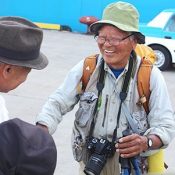
May 23, 2019 Ryukyu Shimpo
A photojournalist taking a walking tour along the Japanese islands, Bunyo Ishikawa, 81, arrived on Okinawa’s main island on May 22. In July 2018 Ishikawa started out from Cape Soya, Hokkaido, and it has taken him about 10 months to set foot on Okinawan soil. Ishikawa took a ferry from Kagoshima Prefecture to Motobu Port in Okinawa, where he met some friends. With a smile he said, “I was filled with emotion as Iejima Tacchu came into sight. I’ve come home.”
Ishikawa’s travels began in Hokkaido in July 2018. He has walked about 3,300 kilometers over 10 months. During his travels he was astonished by sights such as the majestic nature of Hokkaido and the huge seawall in Fukushima Prefecture. Having taken 100 pictures a day, he explained: “Taking a photograph means that something moved me. Being able to take many photographs makes me happy above all else.”
In support of his hope to see a peaceful Okinawa in his lifetime, he wore a T-shirt that read “Toward an Okinawa without military bases,” as he continued his foot tour of Okinawa Island.
He aims to reach Naha City by June 8, then walk to the construction site of the Futenma Replacement Facility in Henoko, Nago City and the Northern Training Area in Takae, Higashi Village. He said, “I think it is my job to convey Okinawa’s current circumstances to the mainland, starting with Henoko.”
(English translation by T&CT and Erin Jones)
Go to Japanese

May 18, 2019 Ryukyu Shimpo
Gov. Denny Tamaki was asked about the “Okinawan spirit” during a regular press conference held on May 17, on account of the 47th anniversary of Okinawa’s reversion to Japan from U.S. rule. The governor explained the Okinawan spirit is “appreciating the chimugukuru (Okinawan heart) passed down from our uyafafuji (ancestors); people helping each other while appreciating independence, coexistence and diversity; mutual cooperation towards everyone’s shared happiness and not leaving anyone behind; and aspiring to actualize these ideas and philosophy.” Tamaki’s motto, “an Okinawan society in which no one is left behind,” serves as the pillar in prefectural government policies—it appears the governor has layered his personal philosophy onto the “Okinawan spirit” in his interpretation.
Gov. Tamaki also explained chimugukuru as “a shared sense of selflessness, an Okinawan identity of wanting to help others.”
Past governors have all shared their views on the “Okinawan spirit.” Junji Nishime’s take, “yearning to be yamatonchu (Japanese), while not being able to embrace it in our hearts,” is an anecdote still repeated today. Ota Masahide, on the other hand, regarded the Okinawan spirit as “a peace-loving spirit of coexistence,” while Keiichi Inamine viewed it as a “combination of the past three governors’ interpretations.”
The late Gov. Takeshi Onaga had articulated the Okinawan sprit as “the spirit of living proud, while honoring the hard work and adversities experienced by our uyafafuji, and thinking about the happiness of our children and grandchildren.”
(English translation by T&CT and Monica Shingaki)
Go to Japanese
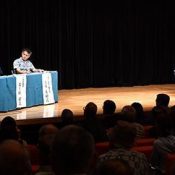
May 19, 2019 Ryukyu Shimpo
On May 18, the Okinawa External Affairs Study Group held a 20th anniversary symposium titled “The Imaginative Power to Stop Henoko” at the Okinawa Prefectural Museum and Art Museum in Omoromachi, Naha. Former Kwansei Gakuin University professor Narahiko Toyoshita gave the keynote speech, in which he spoke of the need to call for demilitarization from Okinawa in response to global militarization as seen in the Okinawa base issue and the friction between the U.S. and China.
Toyoshita argued that “800,000 Okinawans were thrown into an abnormal state in which they were governed by no constitution and had no nationality” in April 1952 as a result of Article 3 of the Treaty of San Francisco. He stated that even when the United Nations adopted the Declaration on the Granting of Independence to Colonial Countries and Peoples in 1960, “making Article 3 a dead letter, the [Japanese] government made no protest to the United States, and the U.S. blue-sky policy, whereby ‘the United States will rule Okinawa until the sky over East Asia is cloudless and blue,’ remains in effect today.”
“Prime Minister Shinzo Abe told President Putin that U.S. military bases will not be installed on the two islands even after their return” during Japan-Russia negotiations over the Northern Territories, said Toyoshita. “He announced that Japan has veto power under the Status of Forces Agreement.” Therefore, “[Abe] must certainly be able to demand that the United States conform to the Civil Aeronautics Act with respect to eliminating the dangers posed by Futenma Air Station.”
The tension between the U.S. and China has caused many nations to arm themselves more heavily, and in 2018 global military expenditure reached 203 trillion yen. “They say that militarization occurs because there are threats, but militarization is itself the threat. We must focus on how to turn that realization into popular opinion,” emphasized Toyoshita. He discussed the United Nations’ Agenda for Disarmament, which lays out an action plan for disarmament, and said, “Okinawa should become a cornerstone of disarmament.”
After the keynote speech, experts discussed issues with the Henoko new base construction and possible resolutions. Okinawa External Affairs Study Group representative and University of the Ryukyus professor Masaaki Gabe facilitated the discussion.
(English translation by T&CT and Sandi Aritza)
Go to Japanese

May 19, 2019 Ryukyu Shimpo online edition
It has been 47 years since Okinawa was returned to Japanese sovereignty after its period of U.S. military occupation, post-war. On the afternoon of May 19 the 5/15 the Peace March Action Committee and the Okinawa Peace Movement Center organized a prefectural citizens’ rally to protect peace and life, held at Ginowan Seaside Park’s Outdoor Theater in Ginowan City. According to the organizers about 2,000 people thronged to the site on May 17 for the beginning of the peace march and rally. The functional enhancement of military bases is being advanced, which acts as a rejection of the call to restore Okinawa to the state it was in prior to being sacrificed in war.
Hiroji Yamashiro, chairman of the Okinawa Peace Movement Center and of the Peace March Action Committee, delivered a greeting from the organizers. He emphasized, “In three years’ time, it will have been 50 years since the return [of Okinawa]. I want to do my best for the future of Okinawa, and the future of Japan.”
Representative Hiroshi Ashitomi of the Helicopter Base Objection Association made a statement about House of Representatives member Hodoka Maruyama’s inquiry to a former islander about Japan reclaiming the northern territories via war. Ashitomi expressed a sense of impending crisis with the words, “It’s up to us to force Diet members fanning the flames of war out of office.”
The rally declarations pointed out that contrary to strong calls for the “prompt and unconditional restoration of all of Okinawa to a peaceful island,” the U.S. military bases remain in place under the the Treaty of Mutual Cooperation and Security between the U.S. and Japan, and even “continue to be strengthened and expanded.” These declarations also brought to attention the problem of the Self-Defense Forces being deployed to Yonaguni Island, Miyako Island, and Ishigaki Island, among others, on the pretense of defending the islands. This declaration stated, “[The deployment] is equal to returning to the atrocious Battle of Okinawa 74 years ago, when [Okinawa] was sacrificed.”
These declaration also brought to attention that, “The U.S. and Japanese governments are forcing through the strengthening and expansion of U.S. military bases as we demonstrate our strong oppostion, and firmly demand a drastic revision of the unjust U.S.-Japan Status of Forces Agreement.”
On the morning of May 19, the final day of the 5/15 Peace March, people departed from the Ginowan City Office and divided to walk north and south courses, surrounding Futenma Air Station on their march. Marchers converged at the meeting place for the prefectural citizens’ rally. Over three days, May 17 through May 19, about 3,590 people in total participated in the peace march, along the central north region “base” course or southern “old battlefield” course.
(English translation by T&CT and Erin Jones)
Go to Japanese
May 18, 2019 Ryukyu Shimpo
A terrible law which conceals the reality of the U.S. bases in Okinawa has been passed. An amendment to a drone regulation law that prohibits small unmanned drones from flying over U.S. military bases in Japan and Japan Self Defense Forces (JSDF) facilities was recently passed in the House of Councillors by the Liberal Democratic Party (LDP)-led coalition.
The law restricts drone flights within a roughly 300 meter perimeter of facilities and land designated by the Minister of Defense. Prior approval from the facility management will be needed in order to fly. The penalty for breaking this law is a maximum one-year prison sentence and 500,000 yen fine. Police and JSDF officials are allowed to confiscate and destroy the drones of apprehended lawbreakers.
The biggest problem with this law is that, under the guise of preventing terrorism, it infringes on Japanese citizen’s right to information. If these drones are prohibited from taking aerial photographs, it severely restricts the information gathering capabilities of news organizations. This results in a veil being lowered over the bases and their surrounding areas, making it difficult to grasp the situations at these places.
The group that bears the brunt of the effects of these new laws are the people of Okinawa, who have had 70% of all of U.S. military installations in Japan thrust upon them, and are forced to live in the shadow of the bases.
Soon, the Japanese government will designate the no-fly zones, and possible locations include the 32 U.S. military installations and their surroundings, 27 nautical areas such as off the coast of Camp Schwab, and 20 zones of airspace.
Even if drones are used according to regulations, it is possible that the confiscation of private drones could become a daily occurrence, as facility management can do so at their discretion.
The countless problems that emanate from the bases will become hard to oversee, and residents will be placed even further outside the curtain. There are concerns that when disaster happens, it will be difficult to quickly get a grasp of the damage.
The U.S. has been petitioning Japan to outlaw drone flights around the bases. This amendment is Japan’s friendly response to this request. It can only be seen as Japan prioritizing the whims of the United States over their own citizen’s right to know.
The Ministry of Defense has stated that they requested the U.S. make judgements that respect the freedom of the press, but this appears to be no more than the construction of an alibi.
This is made apparent by the LDP’s rejection of a proposed amendment put forth by the Constitutional Democratic Party of Japan (CDP), which created a rule that recognized flights for journalistic purposes. The LDP have stated this was done at the behest of the Abe administration.
If a major incident occurs in or around a U.S. military base, will the U.S. military actually allow Japanese news organizations to take aerial photographs by drone? Instead, won’t this incentivize them to try and conceal it?
The fear is that the U.S. military will use this new law to further escalate their outrageous behavior with their new lack of oversight. Is undeniable that part of this is an attempt to “cover up” the activity at U.S. military bases by both the Japanese and American governments.
Does the Japanese government want to regress the country to pre-war times, when laws that restricted photography around bases existed? We absolutely cannot approve of a posture by the Japanese government that cedes the rights of Japanese citizens to the United States.
(English translation by T&CT and Sam Grieb)
Go to Japanese










 Webcam(Kokusai Street)
Webcam(Kokusai Street)


